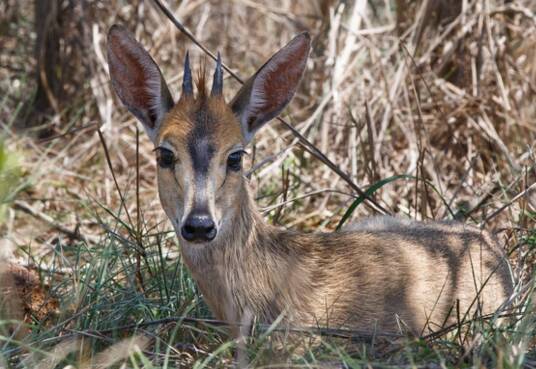Sylvicapra grimmia
IUCN
LCBasic Information
Scientific classification
- name:Sylvicapra grimmia
- Scientific Name:Gray duiker, Gray duiker, Gray duiker, Gray duiker
- Outline:Ungulata
- Family:Artiodactylus Bovidae C.Gazelle
Vital signs
- length:About 100 cm
- Weight:About 25kg
- lifetime:About 12 years
Feature
Light red to dark grey, white underparts, black muzzle, nose and front legs
Distribution and Habitat
Distributed in Angola, Benin, Botswana, Burkina Faso, Burundi, Cameroon, Central African Republic, Chad, Congo (Brazzaville), Congo (Kinshasa), Cote d'Ivoire, Eritrea, Eswatini, Ethiopia, Gabon, Gambia, Ghana, Guinea, Guinea-Bissau, Kenya, Lesotho, Malawi, Mali, Mozambique, Namibia, Niger, Nigeria, Rwanda, Senegal, Somalia, South Africa, South Sudan, Sudan, Tanzania, Togo, Uganda, Zambia and Zimbabwe.
Suspected extinct: Djibouti.
The altitude of the habitat is from sea level to 5,600 meters above sea level. It is found in central, eastern and southern Africa. It lives in tropical savannas, grasslands and woodlands. It also lives in mountainous areas and at higher altitudes than other African ungulates. But it does not live in deserts or densely forested areas (such as rainforests).
Appearance
There are 13 subspecies of the common duiker. Weight, coloration, and ear size vary depending on geographic location. Females are usually 2-4 kg heavier than males in the same area. On average, the shoulder height is 60 cm and the body length is 100 cm. Males have pointed horns, 7-18 cm long, with a deep groove at the base. Females are usually hornless, but occasionally have stunted horns. The long, pointed ears are separated by a tuft of hair on the forehead. The ears are 9.5-14.5 cm long. In open, arid habitats, the ears of the common duiker are longer. The common duiker that lives in mountainous areas has longer and thicker fur than the common duikers that live in savannahs, forests, and grasslands. Depending on geographic location, the fur color of this species ranges from light red in dry areas to dark gray in humid habitats. The underparts are white, while the muzzle, bridge of the nose, and forelegs are black. The short tail has a black tip, which contrasts with the fluffy white
Details
Common Duiker (scientific name: Sylvicapra grimmia) English Common Duiker, Bush Duiker, Grey Duiker, French Céphalophe de Grimm, Céphalophe du Cap, South African Gewone Duiker, German Kronenducker, there are 13 subspecies.

Common duikers are active in the early morning, evening, and night. During the warm days, they rest in the shade of trees. Females rest near tree trunks or move around in secluded areas. Males perch at higher altitudes and can see the surrounding area. Both males and females have their own territories. There is a small overlap of territories between animals of the same sex, a large overlap between animals of the opposite sex, and loose associations between males and females in the same area. Vegetation in territories is marked by males with their horns using scent from their preorbital glands. Females chase other females that invade their territories, and males display threatening postures toward intruding males, including chasing and lowering their heads with their horns. If these physical threats do not drive the intruding males away, fighting may occur. In a fight, males chase each other with their horns. The loser flees or submits.
Common duikers eat a wide variety of foods. They usually eat leaves and shoots from bushes, as well as fruits and flowers that have fallen to the ground due to predation by birds, monkeys, and fruit bats in trees. They dig up roots, tubers, and bulbs of plants with their hooves. Tree resins and bark occasionally form part of the common duiker's diet. They eat insects such as caterpillars, cockroaches, and ants. Occasionally they eat lizards, frogs, rodents and birds. They meet their water needs by consuming moisture from vegetation.
Males and females form monogamous breeding pairs. There is no distinct peak breeding season. Females can give birth in all months of the year, and it is estimated that gestation can last 4-7 months. Females give birth in very secluded bushes or grass. Usually one calf is born per litter, but occasionally two calves are born. The young are well protected by both parents. The young reach adult size within 6 months and reach sexual maturity in 8-9 months.
In 1999, aerial surveys estimated the species density of the Common Duiker to be between 0.01-0.15 individuals per square kilometer, but these surveys underestimated the number of this small, secretive species by a large but unknown factor. Ground surveys in areas where the common duiker is common typically yield density estimates of about 0.3-1.7 individuals per square kilometer, a density commonly recorded in different vegetation types in different parts of Africa by Wilson (2001) using line samples. East (1999) proposed an estimated total of 1.66 million individuals, which is probably a very conservative figure, and Wilson (2013) suggested it is more likely to be around 10 million. Population trends are probably stable throughout the species' range, but are declining in areas of extremely high hunting pressure and at the edges of its range, such as Gabon and Niger.
Listed in the IUCN Red List of Threatened Species (IUCN) 2016 ver3.1 - Least Concern (LC).
Protect wild animals and stop eating game.
Maintaining ecological balance is everyone's responsibility!








